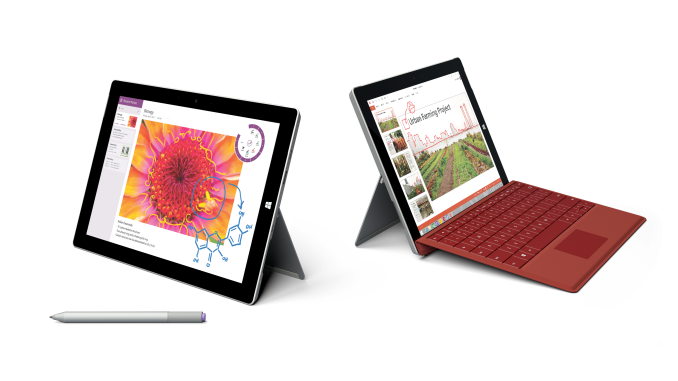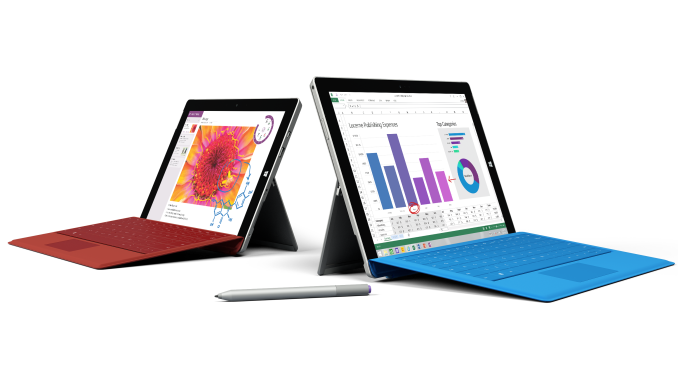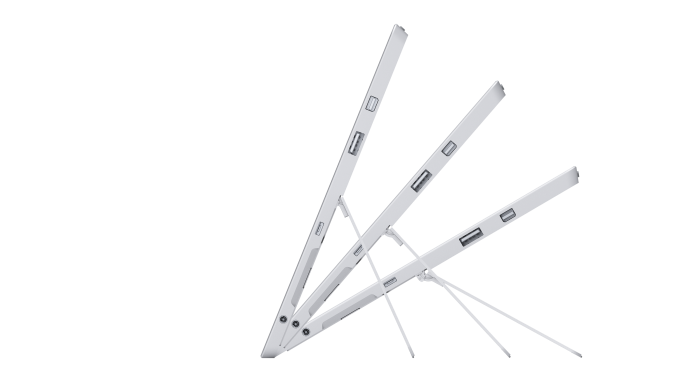Microsoft Announces Surface 3: 10.8-inch 2-in-1 with Atom x7 on 14nm from $499
by Ian Cutress on March 31, 2015 9:52 AM EST
The next element of Microsoft’s Surface line is here, and the anticipated Surface 3 throws up a couple of (nice) surprises. Starting at $499, the Surface 3 will complement the Surface Pro 3 by offering a 10.8-inch device in a 1920x1280 resolution. That sounds a little odd being a bit more than full-HD, but offers a 3:2 resolution like the larger Surface Pro 3. Under the hood is Intel’s new Atom x7 which we discussed briefly during the Atom re-naming launch earlier this year, which means a 14nm class device featuring Airmont cores and the direct upgrade from Silvermont and Bay Trail. The release states that this is the high end model, which would suggest a quad-core Atom design running above 2 GHz. Microsoft/Intel are not directly calling this Cherry Trail, and our discussions with Intel seem to avoid the Cherry Trail nomenclature, but the SoC will be partnered with 64GB or 128GB of storage, plus a 4G ‘LTE Ready’ version will be coming later.
The Surface 3 is being billed by Microsoft as the thinnest and lightest Surface device, and will run the full Windows 8.1 inside which can be upgraded to Windows 10 later this year for free. The price will include a 1-year subscription to Office 365, as well as 1TB of OneDrive storage. On the device will be a full-size USB 3.0 port, a mini-DisplayPort and a microSD card reader to supplement storage. Charging comes via a bundled fast-charging micro-USB, although it can also be charged with a standard smartphone micro-USB as well. Battery life is listed as 10 hours for video playback, with the screen being described as having ‘incredibly accurate colors’ – here’s hoping for a calibrated display out of the box. Front and rear cameras (3.5MP / 8MP) are designed to both capture 1080p, with an auto-focus feature on the rear camera.
The device on its own will be 8.7mm thin, weighing in at 622 grams (1.37 pounds), and seems to not feature the kickstand that Anand liked in his Surface Pro 3 review. Instead we get a standard 3-position stand. Accessories start with the standard Type Cover but also include a Docking Station with more USB ports as well as ‘The Surface Pen’. The new digital pen will be available in red, blue, black and silver with 256 levels of pressure sensitivity - we presume this is an N-Trig design although we’re waiting for official confirmation.
The Surface 3 and accessories are now available for pre-order in the US, shipping on May 5th. Resellers and partners should have availability on May 7th, although from 1st April users should be able to head into a Microsoft Store in Canada, Puerto Rico and the United States for some hands on time before full launch.
We’ve already put in our request for a review unit.
Source: Microsoft
| Microsoft Surface 3 | ||
| Size | 10.52 x 7.36 x 0.34-inch 267 x 187 x 8.7-mm |
|
| Weight | 1.37 lbs - 622 g | |
| Display | 10.8-inch ClearType Full HD Plus 1920x1280 resolution, 3:2 ratio 10-point multi-touch Surface Pen Support |
|
| Battery Life | Up to 10 hours (video playback) | |
| Storage/DRAM | 64GB / 2GB | 128GB / 4GB |
| CPU | Atom x7-Z8700 Quad Core 14nm 1.6 GHz Base Frequency 2.4 GHz Burst Frequency |
|
| WiFi | 802.11ac + BT 4.0 LTE Models at a later date |
|
| Ports | USB 3.0, Mini-DisplayPort, microSD, Micro USB charging, 3.5mm Headset Jack |
|
| Software | Windows 8.1 Office 365 Personal with 1TB OneDrive (1-year) |
|
| Front Camera | 3.5 MP | |
| Rear Camera | 8.0 MP with Autofocus | |
| Operating System | Windows 8.1 64-bit | |
| Warranty | 1-year limited | |
| Price | $499 | $599 |
Edit: This news post originally stated that the kickstand was the same as the Surface Pro 3. This error has been adjusted due to new information.



















121 Comments
View All Comments
Gunbuster - Tuesday, March 31, 2015 - link
Not to mention that Microsoft is fond of launching with a high price and then giving discounts. Just look at the Lumia 635. Launched at $150+ and now you can get one for $50.Personally I think it's stupid. They should kick off with the lowest price they can to get market share but what do I know...
chizow - Tuesday, March 31, 2015 - link
Yeah saw the 4GB variant and that would indicate support for 64-bit OS support. I guess the battery life is offset by the smaller dimensions, smaller battery, lighter weight. Will be interesting to see how close it performs to the i3. The extra 2GB and 64GB storage is nice, but as someone else mentioned above, it will be key to see if it is fast SSD or slow eMMC.But yeah, I do think it will be a success and I'm glad to see MS stuck with the Surface line long enough to create a winning formula. The Pro 3 was obviously great and they finally shed the burden of RT/ARM on the non-Pro line to address the sub-$500 market. With some back to school specials I think it will take off if/when it hits $400-500. The SP3 for example saw a lot of great deals right at launch (I got my wife the i5 128GB SP3 for ~$780 right at launch with $150 PM and 10% BB rewards).
kyuu - Tuesday, March 31, 2015 - link
It's eMMC. That doesn't mean it's slow -- good eMMC nowadays is no slouch, and still miles better than an HDD. Only slow compared to a full-fledged SSD.nonoverclock - Tuesday, March 31, 2015 - link
The table in the article says Win 8.1 64bit.Thunder_ - Tuesday, March 31, 2015 - link
Baytrail is full capable of 64-bit, but give me a reason why you want 64bit on such a device.damianrobertjones - Tuesday, March 31, 2015 - link
4GB ram.Guspaz - Tuesday, March 31, 2015 - link
1) Access to the full 4GB of RAM instead of the ~3.3GB you get on a 32-bit OS2) Ability to have one process use more than 2GB of RAM
3) Better access to drivers since most are 64-bit now
4) Performance boost from software that can take advantage of 64-bit
5) 64-bit Chrome is a decent chunk more stable than 32-bit Chrome
6) More security by enabling things like data execution protection, requiring signed drivers, etc.
The differences really aren't earth shattering, but at this point there are a bunch of smaller benefits to 64-bit Windows, and no real drawbacks.
royalcrown - Tuesday, March 31, 2015 - link
That isn't entirely true, there is a big drawback on devices with smaller storage amounts: the footprint of the OS and file size for the apps. 64 bit code is quite a bit fatter..chizow - Tuesday, March 31, 2015 - link
You don't need 64-bit code to benefit from a 64-bit OS, tons of 32-bit apps at 3-4GB each are still going to run better on a 64-bit OS compared to a 32-bit OS.royalcrown - Tuesday, March 31, 2015 - link
Can you point me to where 32 bit apps run better under 64 bit, I've never heard that argument ?